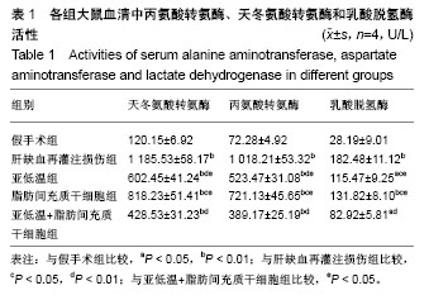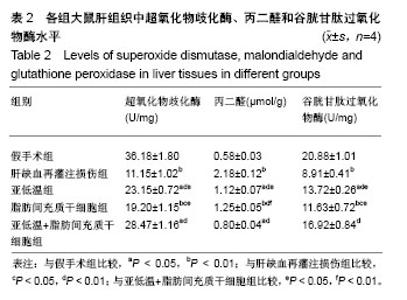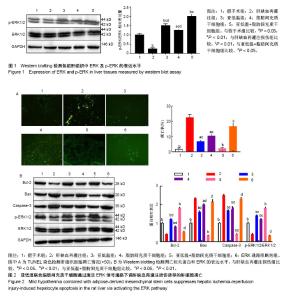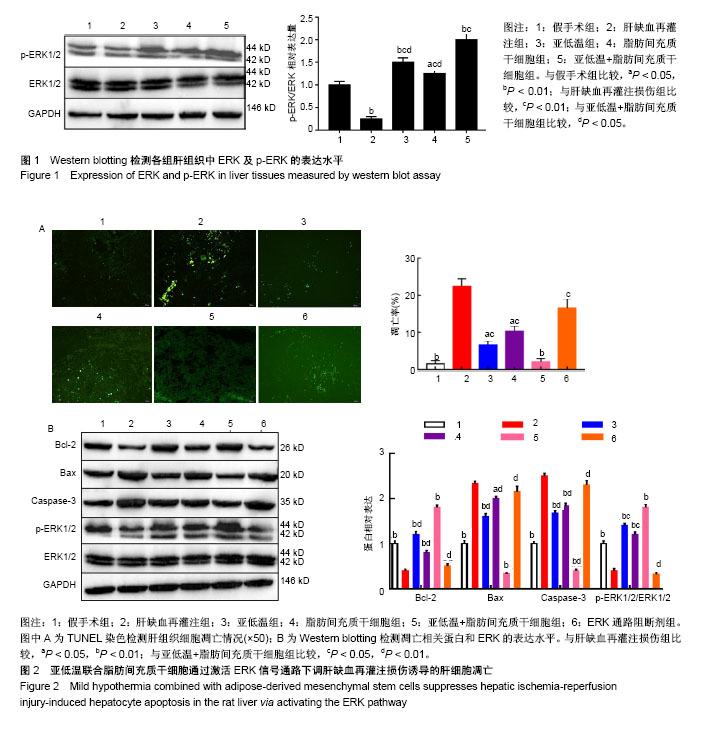Chinese Journal of Tissue Engineering Research ›› 2019, Vol. 23 ›› Issue (13): 2081-2087.doi: 10.3969/j.issn.2095-4344.1691
Previous Articles Next Articles
Mild hypothermia combined with adipose-derived mesenchymal stem cells protects hepatic function in hepatic ischemia-reperfusion injury
Liu Jian1, Li Li1, Wang Xiaochuan2, Zhang Shengning1, Li Laibang1, Mang Yuanyi1, Gao Yang1, Chen Yonglin1, Ren Gang1, Li Wang1
- 1Department of Hepatic-biliary-pancreatic Surgery, Calmette International Hospital, the First People’s Hospital of Kunming, Clinical Medical Center of Organ Transplantation of Yunnan Province, Kunming 650224, Yunnan Province, China; 2Department of Dermatology, the First People’s Hospital of Yunnan, Kunming 650032, Yunnan Province, China
-
Online:2019-05-08Published:2019-05-08 -
Contact:Li Li, MD, Chief physician, Department of Hepatic-biliary-pancreatic Surgery, Calmette International Hospital, the First People’s Hospital of Kunming, Clinical Medical Center of Organ Transplantation of Yunnan Province, Kunming 650224, Yunnan Province, China -
About author:Liu Jian, MD, Associate chief physician, Department of Hepatic-biliary-pancreatic Surgery, Calmette International Hospital, the First People’s Hospital of Kunming, Clinical Medical Center of Organ Transplantation of Yunnan Province, Kunming 650224, Yunnan Province, China
CLC Number:
Cite this article
Liu Jian, Li Li, Wang Xiaochuan, Zhang Shengning, Li Laibang, Mang Yuanyi, Gao Yang, Chen Yonglin, Ren Gang, Li Wang. Mild hypothermia combined with adipose-derived mesenchymal stem cells protects hepatic function in hepatic ischemia-reperfusion injury[J]. Chinese Journal of Tissue Engineering Research, 2019, 23(13): 2081-2087.
share this article

2.1 亚低温联合脂肪间充质干细胞改善肝缺血再灌注损伤大鼠肝功能 通过全自动生化分析仪检测各组肝缺血再灌注12 h后大鼠血清中丙氨酸转氨酶、天冬氨酸转氨酶和乳酸脱氢酶活性。从表1中可以看出,肝缺血再灌注损伤组、亚低温组、脂肪间充质干细胞组、亚低温+脂肪间充质干细胞组血清中3种酶的活性显著高于假手术组(P < 0.05和P < 0.01),亚低温组、脂肪间充质干细胞组、亚低温+脂肪间充质干细胞组血清中3种酶的活性均显著低于肝缺血再灌注损伤组(P < 0.05和P < 0.01)。亚低温+脂肪间充质干细胞组大鼠血清中3种酶的活性明显低于亚低温组和脂肪间充质干细胞组(P < 0.05)。由此可知,亚低温联合脂肪间充质干细胞可显著下调肝缺血再灌注损伤大鼠血清中丙氨酸转氨酶、天冬氨酸转氨酶和乳酸脱氢酶活性,进而改善肝缺血再灌注损伤大鼠的肝功能。"


2.2 亚低温联合脂肪间充质干细胞减轻肝缺血再灌注损伤诱导的氧化应激 采用试剂盒检测各组大鼠肝组织中超氧化物歧化酶、丙二醛和谷胱甘肽过氧化物酶水平。从表2中可发现,肝缺血再灌注损伤组、亚低温组、脂肪间充质干细胞组、亚低温+脂肪间充质干细胞组肝组织中超氧化物歧化酶和谷胱甘肽过氧化物酶水平显著低于假手术组(P < 0.05和P < 0.01),而丙二醛含量显著高于假手术组(P < 0.05和P < 0.01)。同时,亚低温组、脂肪间充质干细胞组、亚低温+脂肪间充质干细胞组肝组织中超氧化物歧化酶和谷胱甘肽过氧化物酶水平显著高于肝缺血再灌注损伤组 (P < 0.05和P < 0.01),而丙二醛含量低于肝缺血再灌注损伤组(P < 0.01)。亚低温+脂肪间充质干细胞组肝组织中超氧化物歧化酶和谷胱甘肽过氧化物酶水平显著高于亚低温组和脂肪间充质干细胞组(P < 0.05),而丙二醛含量低于亚低温组和脂肪间充质干细胞组(P < 0.05和P < 0.01)。由此可知,亚低温联合脂肪间充质干细胞可缓解肝缺血再灌注损伤诱导的氧化应激。 2.3 亚低温联合脂肪间充质干细胞对ERK信号通路的影响 采用Western blotting检测各组肝组织中ERK1/2的磷酸化水平,见图1。肝缺血再灌注损伤组中p-ERK1/2的相对表达量明显低于假手术组(P < 0.01);亚低温组、脂肪间充质干细胞组、亚低温+脂肪间充质干细胞组肝组织中p-ERK1/2的相对表达量显著高于肝缺血再灌注损伤组 (P < 0.01),且亚低温+脂肪间充质干细胞组肝组织中p-ERK1/2的相对表达量显著高于亚低温组和脂肪间充质干细胞组(P < 0.05),但ERK蛋白的表达水平在各组间差异无显著性意义。由此可知,亚低温联合脂肪间充质干细胞处理后激活了ERK信号通路。"


2.4 亚低温联合脂肪间充质干细胞通过激活ERK信号通路下调肝细胞凋亡 TUNEL染色结果显示,肝缺血再灌注损伤组细胞凋亡率[(22.35±2.1)%]显著高于假手术组[(1.52±0.86)%],差异有显著性意义(P < 0.01);亚低温组[(6.57±1.24)%]、脂肪间充质干细胞组[(10.23±1.58)%]、亚低温+脂肪间充质干细胞组[(2.01±0.90)%]细胞凋亡率明显下降,与肝缺血再灌注损伤组比较差异有显著性意义 (P < 0.05,P < 0.01)。同时,亚低温+脂肪间充质干细胞组肝细胞凋亡率显著低于亚低温组和脂肪间充质干细胞组(P < 0.05),而ERK通路阻断剂组[(16.58±2.58)%]肝细胞凋亡率与肝缺血再灌注损伤组差异无显著性意义(P > 0.05),见图2A。 Western blotting检测凋亡相关蛋白表达,见图2B。与假手术组相比,肝缺血再灌注损伤组抗凋亡蛋白Bcl-2表达水平下降(P < 0.01),促凋亡蛋白Bax和Caspase-3表达水平升高(P < 0.01)。与肝缺血再灌注损伤组相比,亚低温组、脂肪间充质干细胞组、亚低温+脂肪间充质干细胞组Bcl-2表达水平上升(P < 0.01),Bax和caspase-3表达水平下降(P < 0.05,P < 0.01),而ERK通路阻断剂组Bax、Bcl-2和Caspase-3蛋白表达水平与肝缺血再灌注损伤组差异无显著性意义(P > 0.05)。由此可知,亚低温联合脂肪间充质干细胞通过激活ERK信号通路下调肝细胞凋亡,进而缓解肝缺血再灌注损伤。"

| [1] 吴勤荣,时军,王永刚. 细胞凋亡与肝移植缺血再灌注损伤[J]. 中国组织工程研究与临床康复, 2011,15(18):3371-3375.[2] Martikos G, Kapelouzou A, Peroulis M, et al. Remote Ischemic Preconditioning Decreases the Magnitude of Hepatic Ischemia-Reperfusion Injury on a Swine Model of Supraceliac Aortic Cross-Clamping. Ann Vasc Surg. 2018; 48:241-250.[3] Li Y, Yang Y, Feng Y, et al. A review of melatonin in hepatic ischemia/reperfusion injury and clinical liver disease. Ann Med. 2014;46(7):503-511.[4] 陈茂松,王军,欧雷. 促红细胞生成素对大鼠肝脏缺血再灌注损伤的抗炎作用[J]. 广东医学,2016,37(6):828-830.[5] Hernandez-Alejandro R, Zhang X, Croome KP, et al. Reduction of liver ischemia reperfusion injury by silencing of TNF-α gene with shRNA. J Surg Res. 2012;176(2):614-620.[6] Behrends M, Hirose R, Serkova NJ, et al. Mild hypothermia reduces the inflammatory response and hepatic ischemia/ reperfusion injury in rats. Liver Int. 2006;26(6):734-741.[7] Sia D, Hoshida Y, Villanueva A, et al. Integrative molecular analysis of intrahepatic cholangiocarcinoma reveals 2 classes that have different outcomes. Gastroenterology. 2013;144(4): 829-840.[8] Yin TC, Wu RW, Sheu JJ, et al. Combined Therapy with Extracorporeal Shock Wave and Adipose-Derived Mesenchymal Stem Cells Remarkably Improved Acute Ischemia-Reperfusion Injury of Quadriceps Muscle. Oxid Med Cell Longev. 2018;2018:6012636.[9] Zhang JB, Wang XQ, Lu GL, et al. Adipose-derived mesenchymal stem cells therapy for acute kidney injury induced by ischemia-reperfusion in a rat model. Clin Exp Pharmacol Physiol. 2017;44(12):1232-1240.[10] Lin KC, Yip HK, Shao PL, et al. Combination of adipose-derived mesenchymal stem cells (ADMSC) and ADMSC-derived exosomes for protecting kidney from acute ischemia-reperfusion injury. Int J Cardiol. 2016;216:173-185.[11] Yin TC, Wu RW, Sheu JJ, et al. Combined Therapy with Extracorporeal Shock Wave and Adipose-Derived Mesenchymal Stem Cells Remarkably Improved Acute Ischemia-Reperfusion Injury of Quadriceps Muscle. Oxid Med Cell Longev. 2018;2018:6012636.[12] Tanzi MC, Farè S. Adipose tissue engineering: state of the art, recent advances and innovative approaches. Expert Rev Med Devices. 2009;6(5):533-551.[13] Choi JW, Shin S, Lee CY, et al. Rapid Induction of Osteogenic Markers in Mesenchymal Stem Cells by Adipose-Derived Stromal Vascular Fraction Cells. Cell Physiol Biochem. 2017; 44(1):53-65.[14] Zhou L, Song Q, Shen J, et al. Comparison of human adipose stromal vascular fraction and adipose-derived mesenchymal stem cells for the attenuation of acute renal ischemia/ reperfusion injury. Sci Rep. 2017;7:44058.[15] Saito K, Fukuda N, Matsumoto T, et al. Moderate low temperature preserves the stemness of neural stem cells and suppresses apoptosis of the cells via activation of the cold-inducible RNA binding protein. Brain Res. 2010;1358: 20-29.[16] 邱季,方芳,李珍,等. ERK-CREB信号通路在白藜芦醇预处理对大鼠局灶性脑损伤缺血再灌注损伤神经保护中的作用[J].安徽医科大学学报, 2013, 48(10):1152-1155.[17] 刘琴,林亚平,陈文,等.针刺联合亚低温对脑损伤缺血再灌注损伤大鼠脑组织p-Raf1、p-ERK1/2的影响[J].湖南中医药大学学报, 2016, 36(1):58-62.[18] Choi DE, Jeong JY, Choi H, et al. ERK phosphorylation plays an important role in the protection afforded by hypothermia against renal ischemia-reperfusion injury. Surgery. 2017; 161(2):444-452.[19] Chen Y, Ba L, Huang W, et al. Role of carvacrol in cardioprotection against myocardial ischemia/reperfusion injury in rats through activation of MAPK/ERK and Akt/eNOS signaling pathways. Eur J Pharmacol. 2017;796:90-100.[20] Lin B, Yu H, Lin Y, et al. Suppression of GRASP65 phosphorylation by tetrahydrocurcumin protects against cerebral ischemia/reperfusion injury via ERK signaling. Mol Med Rep. 2016;14(5):4775-4780.[21] 史光军,张亚东,胡音音,等. 脂肪间充质干细胞移植上调肝脏增殖细胞核抗原表达促进肝细胞的再生[J]. 中国组织工程研究, 2017, 21(17):2690-2695.[22] Kohli V, Selzner M, Madden JF, et al. Endothelial cell and hepatocyte deaths occur by apoptosis after ischemia-reperfusion injury in the rat liver. Transplantation. 1999;67(8):1099-1105.[23] Granger DN, Kvietys PR. Reperfusion injury and reactive oxygen species: The evolution of a concept. Redox Biol. 2015;6:524-551.[24] Pell VR, Spiroski AM, Mulvey J, et al. Ischemic preconditioning protects against cardiac ischemia reperfusion injury without affecting succinate accumulation or oxidation. J Mol Cell Cardiol. 2018;123:88-91.[25] Yang YF, Zhang MF, Tian QH, et al. SPAG5 interacts with CEP55 and exerts oncogenic activities via PI3K/AKT pathway in hepatocellular carcinoma. Mol Cancer. 2018;17(1):117.[26] Dai HB, Xu MM, Lv J, et al. Mild Hypothermia Combined with Hydrogen Sulfide Treatment During Resuscitation Reduces Hippocampal Neuron Apoptosis Via NR2A, NR2B, and PI3K-Akt Signaling in a Rat Model of Cerebral Ischemia-Reperfusion Injury. Mol Neurobiol. 2016;53(7): 4865-4873.[27] Xiao Q, Ye QF, Wang W, et al. Mild hypothermia pretreatment protects hepatocytes against ischemia reperfusion injury via down-regulating miR-122 and IGF-1R/AKT pathway. Cryobiology. 2017;75:100-105.[28] Adachi N, Liu K, Motoki A, et al. A comparison of protective effects between L-histidine and hypothermia against ischemia-induced neuronal damage in gerbil hippocampus. Eur J Pharmacol. 2006;546(1-3):69-73.[29] Erlinge D. A Review of Mild Hypothermia as an Adjunctive Treatment for ST-Elevation Myocardial Infarction. Ther Hypothermia Temp Manag. 2011;1(3):129-141.[30] Zhu P, Zhao MY, Li XH, et al. Effect of low temperatures on BAX and BCL2 proteins in rats with spinal cord ischemia reperfusion injury. Genet Mol Res. 2015;14(3):10490-10499.[31] Santos EB, Koff WJ, Grezzana Filho Tde J, et al. Oxidative stress evaluation of ischemia and reperfusion in kidneys under various degrees of hypothermia in rats. Acta Cir Bras. 2013; 28(8):568-573.[32] Zhou T, Liang L, Liang Y, et al. Mild hypothermia protects hippocampal neurons against oxygen-glucose deprivation/reperfusion-induced injury by improving lysosomal function and autophagic flux. Exp Cell Res. 2017;358(2): 147-160.[33] Kanagawa T, Fukuda H, Tsubouchi H, et al. A decrease of cell proliferation by hypothermia in the hippocampus of the neonatal rat. Brain Res. 2006;1111(1):36-40.[34] 高小月,张玉泉,杨晓清,等. 人脐带间充质干细胞在组织损伤修复中的研究进展[J]. 生物医学工程与临床, 2018, 22(2):208-213.[35] Lo CY, Weil BR, Palka BA, et al. Cell surface glycoengineering improves selectin-mediated adhesion of mesenchymal stem cells (MSCs) and cardiosphere-derived cells (CDCs): Pilot validation in porcine ischemia-reperfusion model. Biomaterials. 2016;74:19-30.[36] 王汝霖,林淼,黎力平,等. 骨髓间充质干细胞来源exosome对大鼠肾缺血再灌注损伤的保护作用[J]. 中华医学杂志,2014, 94(42): 3298-3303.[37] Yu Y, Lu L, Qian X, et al. Antifibrotic effect of hepatocyte growth factor-expressing mesenchymal stem cells in small-for-size liver transplant rats. Stem Cells Dev. 2010;19(6): 903-914.[38] Devey L, Mohr E, Bellamy C, et al. c-Jun terminal kinase-2 gene deleted mice overexpress hemeoxygenase-1 and are protected from hepatic ischemia reperfusion injury. Transplantation 2009;88(3):308-316.[39] Kanazawa H, Fujimoto Y, Teratani T, et al. Bone marrow-derived mesenchymal stem cells ameliorate hepatic ischemia reperfusion injury in a rat model. PLoS One. 2011; 6(4):e19195.[40] Pan GZ, Yang Y, Zhang J, et al. Bone marrow mesenchymal stem cells ameliorate hepatic ischemia/reperfusion injuries via inactivation of the MEK/ERK signaling pathway in rats. J Surg Res. 2012;178(2):935-948. |
| [1] | Zhang Tongtong, Wang Zhonghua, Wen Jie, Song Yuxin, Liu Lin. Application of three-dimensional printing model in surgical resection and reconstruction of cervical tumor [J]. Chinese Journal of Tissue Engineering Research, 2021, 25(9): 1335-1339. |
| [2] | Chen Jiming, Wu Xiaojing, Liu Tianfeng, Chen Haicong, Huang Chengshuo. Effects of silymarin on liver injury and bone metabolism induced by carbon tetrachloride in mice [J]. Chinese Journal of Tissue Engineering Research, 2021, 25(8): 1224-1228. |
| [3] | Zeng Yanhua, Hao Yanlei. In vitro culture and purification of Schwann cells: a systematic review [J]. Chinese Journal of Tissue Engineering Research, 2021, 25(7): 1135-1141. |
| [4] | Wang Hanyue, Li Furong, Yang Xiaofei, Hu Chaofeng. Direct reprogramming hepatocytes into islet-like cells by efficiently targeting and activating the endogenous genes [J]. Chinese Journal of Tissue Engineering Research, 2021, 25(7): 1056-1063. |
| [5] | Xu Dongzi, Zhang Ting, Ouyang Zhaolian. The global competitive situation of cardiac tissue engineering based on patent analysis [J]. Chinese Journal of Tissue Engineering Research, 2021, 25(5): 807-812. |
| [6] | Liu Yang, Gong Yi, Fan Wei. Anti-hepatoma activity of targeted Pluronic F127/formononetin nanocomposite system in vitro [J]. Chinese Journal of Tissue Engineering Research, 2021, 25(4): 526-531. |
| [7] | Wu Zijian, Hu Zhaoduan, Xie Youqiong, Wang Feng, Li Jia, Li Bocun, Cai Guowei, Peng Rui. Three-dimensional printing technology and bone tissue engineering research: literature metrology and visual analysis of research hotspots [J]. Chinese Journal of Tissue Engineering Research, 2021, 25(4): 564-569. |
| [8] | Chang Wenliao, Zhao Jie, Sun Xiaoliang, Wang Kun, Wu Guofeng, Zhou Jian, Li Shuxiang, Sun Han. Material selection, theoretical design and biomimetic function of artificial periosteum [J]. Chinese Journal of Tissue Engineering Research, 2021, 25(4): 600-606. |
| [9] | Liu Fei, Cui Yutao, Liu He. Advantages and problems of local antibiotic delivery system in the treatment of osteomyelitis [J]. Chinese Journal of Tissue Engineering Research, 2021, 25(4): 614-620. |
| [10] | Li Xiaozhuang, Duan Hao, Wang Weizhou, Tang Zhihong, Wang Yanghao, He Fei. Application of bone tissue engineering materials in the treatment of bone defect diseases in vivo [J]. Chinese Journal of Tissue Engineering Research, 2021, 25(4): 626-631. |
| [11] | Zhang Zhenkun, Li Zhe, Li Ya, Wang Yingying, Wang Yaping, Zhou Xinkui, Ma Shanshan, Guan Fangxia. Application of alginate based hydrogels/dressings in wound healing: sustained, dynamic and sequential release [J]. Chinese Journal of Tissue Engineering Research, 2021, 25(4): 638-643. |
| [12] | Chen Jiana, Qiu Yanling, Nie Minhai, Liu Xuqian. Tissue engineering scaffolds in repairing oral and maxillofacial soft tissue defects [J]. Chinese Journal of Tissue Engineering Research, 2021, 25(4): 644-650. |
| [13] | Xing Hao, Zhang Yonghong, Wang Dong. Advantages and disadvantages of repairing large-segment bone defect [J]. Chinese Journal of Tissue Engineering Research, 2021, 25(3): 426-430. |
| [14] | Hao Xiaona, Zhang Yingjie, Li Yuyun, Xu Tao. Bone marrow mesenchymal stem cells overexpressing prolyl oligopeptidase on the repair of liver fibrosis in rat models [J]. Chinese Journal of Tissue Engineering Research, 2021, 25(25): 3988-3993. |
| [15] | Fan Junchao, Chen Yong, Song Junjie. Sevoflurance combined with xenon pretreatment protects against spinal cord ischemia-reperfusion injury in a rat model [J]. Chinese Journal of Tissue Engineering Research, 2021, 25(23): 3660-3665. |
| Viewed | ||||||
|
Full text |
|
|||||
|
Abstract |
|
|||||